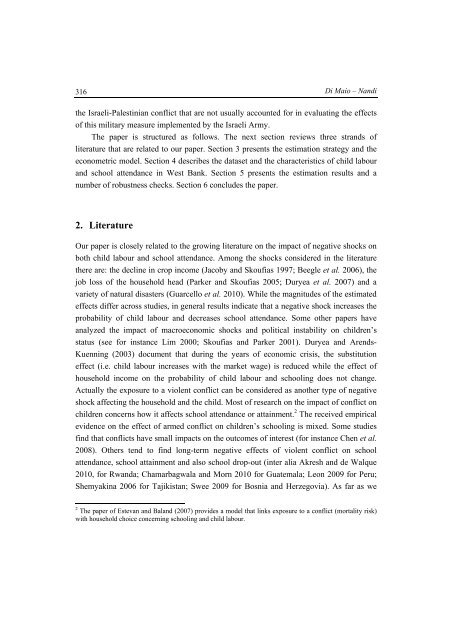The Palestinian Economy. Theoretical and Practical Challenges
The Palestinian Economy. Theoretical and Practical Challenges
The Palestinian Economy. Theoretical and Practical Challenges
Create successful ePaper yourself
Turn your PDF publications into a flip-book with our unique Google optimized e-Paper software.
316<br />
Di Maio – N<strong>and</strong>i<br />
the Israeli-<strong>Palestinian</strong> conflict that are not usually accounted for in evaluating the effects<br />
of this military measure implemented by the Israeli Army.<br />
<strong>The</strong> paper is structured as follows. <strong>The</strong> next section reviews three str<strong>and</strong>s of<br />
literature that are related to our paper. Section 3 presents the estimation strategy <strong>and</strong> the<br />
econometric model. Section 4 describes the dataset <strong>and</strong> the characteristics of child labour<br />
<strong>and</strong> school attendance in West Bank. Section 5 presents the estimation results <strong>and</strong> a<br />
number of robustness checks. Section 6 concludes the paper.<br />
2. Literature<br />
Our paper is closely related to the growing literature on the impact of negative shocks on<br />
both child labour <strong>and</strong> school attendance. Among the shocks considered in the literature<br />
there are: the decline in crop income (Jacoby <strong>and</strong> Skoufias 1997; Beegle et al. 2006), the<br />
job loss of the household head (Parker <strong>and</strong> Skoufias 2005; Duryea et al. 2007) <strong>and</strong> a<br />
variety of natural disasters (Guarcello et al. 2010). While the magnitudes of the estimated<br />
effects differ across studies, in general results indicate that a negative shock increases the<br />
probability of child labour <strong>and</strong> decreases school attendance. Some other papers have<br />
analyzed the impact of macroeconomic shocks <strong>and</strong> political instability on children’s<br />
status (see for instance Lim 2000; Skoufias <strong>and</strong> Parker 2001). Duryea <strong>and</strong> Arends-<br />
Kuenning (2003) document that during the years of economic crisis, the substitution<br />
effect (i.e. child labour increases with the market wage) is reduced while the effect of<br />
household income on the probability of child labour <strong>and</strong> schooling does not change.<br />
Actually the exposure to a violent conflict can be considered as another type of negative<br />
shock affecting the household <strong>and</strong> the child. Most of research on the impact of conflict on<br />
children concerns how it affects school attendance or attainment. 2 <strong>The</strong> received empirical<br />
evidence on the effect of armed conflict on children’s schooling is mixed. Some studies<br />
find that conflicts have small impacts on the outcomes of interest (for instance Chen et al.<br />
2008). Others tend to find long-term negative effects of violent conflict on school<br />
attendance, school attainment <strong>and</strong> also school drop-out (inter alia Akresh <strong>and</strong> de Walque<br />
2010, for Rw<strong>and</strong>a; Chamarbagwala <strong>and</strong> Morn 2010 for Guatemala; Leon 2009 for Peru;<br />
Shemyakina 2006 for Tajikistan; Swee 2009 for Bosnia <strong>and</strong> Herzegovia). As far as we<br />
2 <strong>The</strong> paper of Estevan <strong>and</strong> Bal<strong>and</strong> (2007) provides a model that links exposure to a conflict (mortality risk)<br />
with household choice concerning schooling <strong>and</strong> child labour.
















